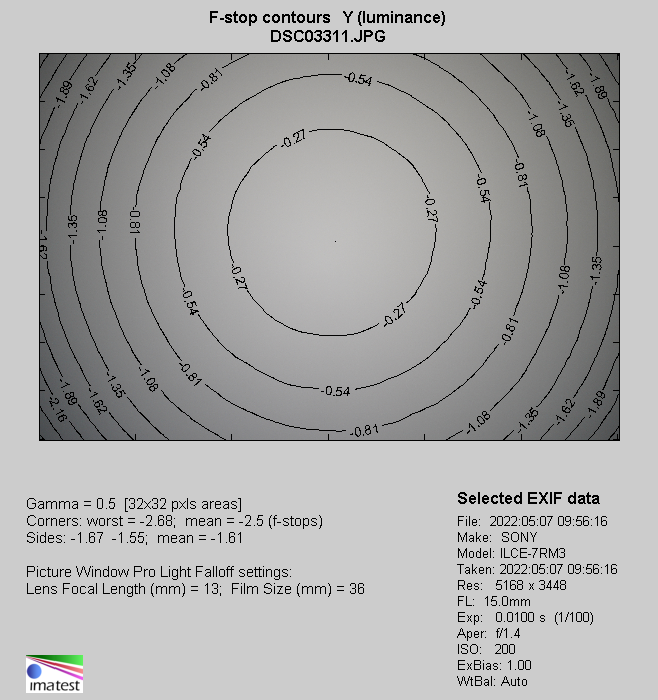Sony E 15 mm f/1.4 G
8. Vignetting
Let's check how the tested lens performs in this category both on JPEG and RAW files developped by neutral software. You have to remember that vignetting on JPEGs isn't corrected but distortion is, and, as a result, the files are cropped. Neutral RAWs show, for a change, exactly what optics does with an image- without distortion and/or vignetting correction.
| A7R III, APS-C, JPEG, f/1.4 | A7R III, APS-C, RAW, f/1.4 |

|

|
| A7R III, APS-C, JPEG, f/2.0 | A7R III, APS-C, RAW, f/2.0 |

|

|
| A7R III, APS-C, JPEG, f/2.8 | A7R III, APS-C, RAW, f/2.8 |

|

|
Please Support UsIf you enjoy our reviews and articles, and you want us to continue our work please, support our website by donating through PayPal. The funds are going to be used for paying our editorial team, renting servers, and equipping our testing studio; only that way we will be able to continue providing you interesting content for free. |
- - - - - - - - - - - - - - - - - - - - - - - - - - - - - - - - - - - - - - - - - - - - - - - -
In case of JPEG files at the maximum relative aperture you have to take into accout the loss of 58% (-2.50 EV) of light in the frame corners. It's a lot but, taking into account the parameters of the tested lens, there are no serious reasons to complain. The result of the Sigma was here noticeably better because it reached just 43% but the Sigma, with a narrower angle of view, was easier to correct.
Stopping down the aperture to f/2.0 decreases vignetting to 35% (-1.27 EV) and after applying f/2.8 you are able to reduce it to 21% (-0.70 EV). Further decrease can be noticed by f/4.0 and f/5.6 where we got, respectively, 15% (-0.48 EV), and 13% (-0.42 EV). Further stopping down of the apperture doesn't have any measureable effect on the aberration, described here.
According to our expectations the results on uncorrected RAW files are higher. At the maximum relative aperture you see a brightness loss in the frame corners amounting to as much as 66% (-3.15 EV); it decreases to 52% (-2.13 EV) on stopping down the aperture to f/2.0. By f/2.8, f/4.0, and f/5.6 apertures we got, respectively, the following results: 41% (-1.52 EV), 34% (-1.19 EV) and 30% (-1.05 EV).
In case of RAW files further stopping down is still effective and by f/8.0 vignetting is 26% (-0.87 EV), and by f/11.0 it drops to 23% (-0.76 EV).
| Sony A7R III, APS-C, JPEG, f/1.4 |
 |






